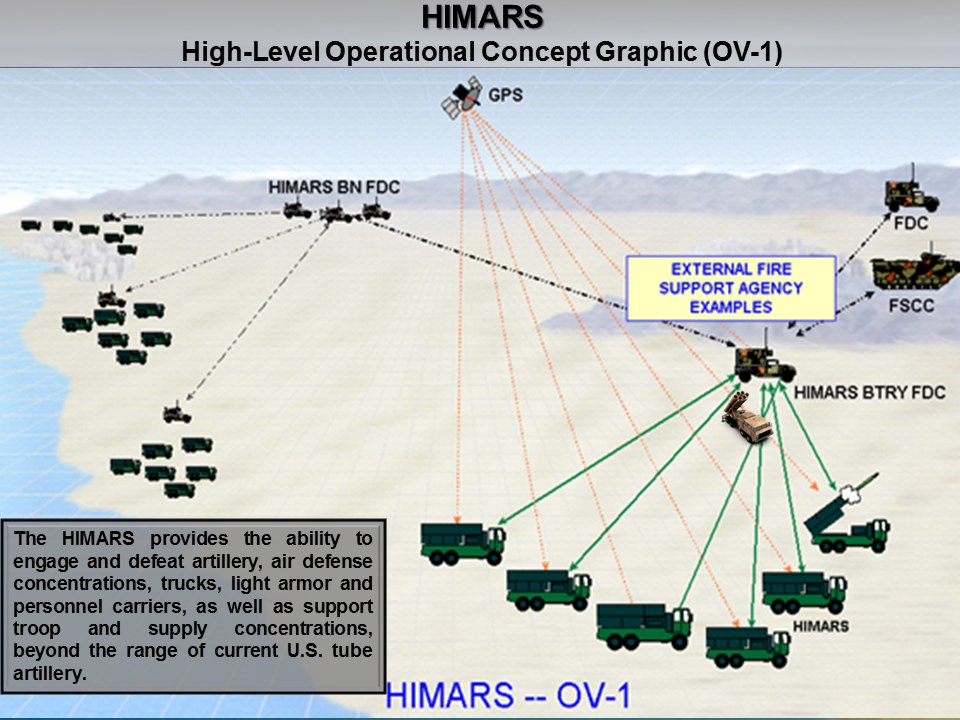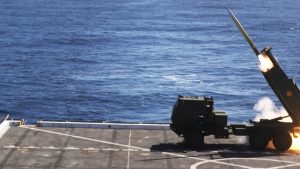10/25/2017: U.S. Marines with Battery R, 5th Battalion, 11th Marine Regiment, 1st Marine Division launch a rocket from a High Mobility Artillery Rocket System (HIMARS) off the USS Anchorage (LPD-23) during Exercise Dawn Blitz, Oct. 22, 2017.
Dawn Blitz 17 allows the amphibious force to integrate the F-35B Lightning II and HIMARS into the exercise to validate a capability with platforms not traditionally used at the Marine Expeditionary Brigade/Expeditionary Strike Group or Marine Expeditionary Unit/Amphibious Ready Group levels.
10.22.2017
Video by Lance Cpl. Victoria Decker
1st Marine Expeditionary Brigade
According to the USMC, the High Mobility Artillery Rocket System is described as follows:
HIMARS is a C-5 transportable, wheeled, indirect fire, rocket/missile system capable of firing all current and future rockets and missiles in the Multiple-Launch Rocket System Family of Munitions (MFOM).
The HIMARS launcher consists of a fire control system, carrier (automotive platform), and launcher-loader module that performs all operations necessary to complete a fire mission.
The basic system is defined as one launcher, one resupply vehicle, and two resupply trailers.
HIMARS addresses an identified, critical warfighting deficiency in Marine Corps fire support.
HIMARS employs the Guided Multiple Launch Rocket System (GMLRS) rocket to provide precision fires in support of the MAGTF. HIMARS is a transformational, responsive, general-support/general-support reinforcing precision indirect fire weapon system that accurately engages targets at long ranges (in excess of 40 miles) with high volumes of lethal precision fires in all weather conditions and throughout all phases of combat operations ashore.
https://marinecorpsconceptsandprograms.com/programs/fire-support/high-mobility-artillery-rocket-system-himars

But this is a platform-centric description not how it can contribute to the fight in a distributed battlespace.
For the Marines, the HIMARS can be used ashore or as they have just demonstrated can be fired from an amphibious ship as well during Dawn Blitz.
And in the most recent WTI exercise, the F-35 operated as the trigger for HIMARS firing.
This development can be missed or simply look like legacy aircraft support to a ground firing capability.
But it is not.
 U.S. Marines with Battery R, 5th Battalion, 11th Marine Regiment, 1st Marine Division launch a rocket from a High Mobility Artillery Rocket System (HIMARS) off the USS Anchorage (LPD-23) during Exercise Dawn Blitz, Oct. 22, 2017. Dawn Blitz 17 allows the amphibious force to integrate the F-35B Lightning II and HIMARS into the exercise to validate a capability with platforms not traditionally used at the Marine Expeditionary Brigade/Expeditionary Strike Group or Marine Expeditionary Unit/Amphibious Ready Group levels. (U.S. Marine Corps photo by Sgt. Logan Block)
U.S. Marines with Battery R, 5th Battalion, 11th Marine Regiment, 1st Marine Division launch a rocket from a High Mobility Artillery Rocket System (HIMARS) off the USS Anchorage (LPD-23) during Exercise Dawn Blitz, Oct. 22, 2017. Dawn Blitz 17 allows the amphibious force to integrate the F-35B Lightning II and HIMARS into the exercise to validate a capability with platforms not traditionally used at the Marine Expeditionary Brigade/Expeditionary Strike Group or Marine Expeditionary Unit/Amphibious Ready Group levels. (U.S. Marine Corps photo by Sgt. Logan Block)
The F-35s sensors onboard provide significant range and ability to target discriminate which can be shared with the ground force to guide their operational trajectories as well as, in the case of HIMARS, a key target to destroy.
With the decision-making ability built into the cockpit of the F-35, the pilots can identify key choke point targets to support ground fires and can themselves add weapons to the fight.
In other words, rather than doing class ground support, the F-35 is capable of integrating the ground fires into an overall distributed strike force.
HIMARS integration with F-35 and the shipboard firing are case studies of the transition of the USMC and not simply case studies of more advanced ways of doing what they have been doing.



 U.S. Marines with Battery R, 5th Battalion, 11th Marine Regiment, 1st Marine Division launch a rocket from a High Mobility Artillery Rocket System (HIMARS) off the USS Anchorage (LPD-23) during Exercise Dawn Blitz, Oct. 22, 2017. Dawn Blitz 17 allows the amphibious force to integrate the F-35B Lightning II and HIMARS into the exercise to validate a capability with platforms not traditionally used at the Marine Expeditionary Brigade/Expeditionary Strike Group or Marine Expeditionary Unit/Amphibious Ready Group levels. (U.S. Marine Corps photo by Sgt. Logan Block)
U.S. Marines with Battery R, 5th Battalion, 11th Marine Regiment, 1st Marine Division launch a rocket from a High Mobility Artillery Rocket System (HIMARS) off the USS Anchorage (LPD-23) during Exercise Dawn Blitz, Oct. 22, 2017. Dawn Blitz 17 allows the amphibious force to integrate the F-35B Lightning II and HIMARS into the exercise to validate a capability with platforms not traditionally used at the Marine Expeditionary Brigade/Expeditionary Strike Group or Marine Expeditionary Unit/Amphibious Ready Group levels. (U.S. Marine Corps photo by Sgt. Logan Block)